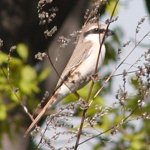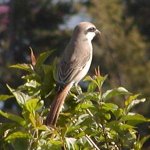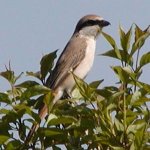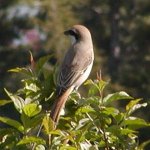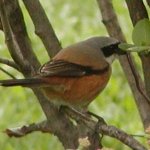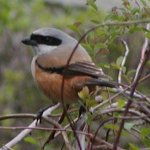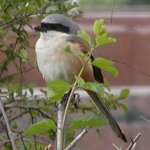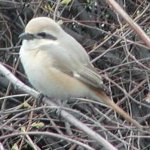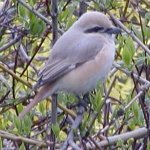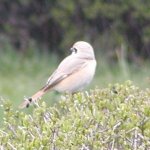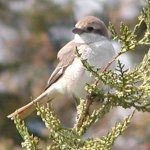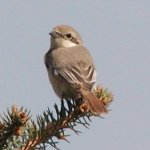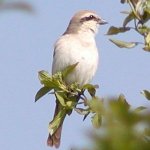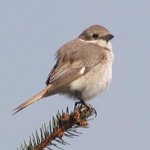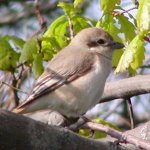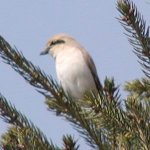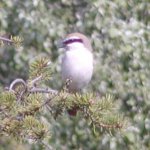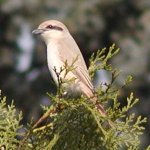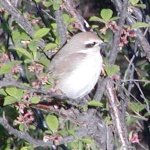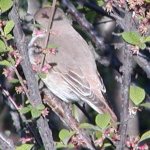Askar Isabekov
Well-known member
Dear friends.
I have made some photos of the shrikes in the park near my hame. I think that most shrike used park as a rest place on the flying. Because I saw birds only one day each (exclude one bird). I try to identify birds. Please tell me what you think.
In first. The information I found in the net.
1. First bird I identify as Turkestan Shrike (L. i. phoenicuroides). Images 1a, 1b, 1c, 1d.
2. Second bird is Long-Tailed Shrike - Lanius schach erythronotus. Photos 2a, 2b, 3c.
3. This bird larger than first and very pale. May be tsaidemensis or arenarius. I think arenarius because this bird live in the park more than one month. May be nesting bird. But it is not L. i. phoenicuroides. Closest nesting place of other subspasies is West China - Xinjiang. Photos 3a, 3b, 3c.
4. One day 5-7 birds attended the park. They are similar size as Turkestan Shrike but not so bright color. Only one male have complete mask. Looks like L. i. isabellinus or L. i. arenarius. Photos 4a, 4b, 4c, 4d, 4e, 4f, 4g, 4h
5. Last bird. May be female L. i. isabellinus. Photos 5a and 5b.
What do you think?
Best regards, Askar.
P.S. All photos made in Alma-Ata, Kazakhstan on April 15-26.
Photos 1a-1d - L. i. phoenicuroides. 2a - Lanius schach erythronotus.
I have made some photos of the shrikes in the park near my hame. I think that most shrike used park as a rest place on the flying. Because I saw birds only one day each (exclude one bird). I try to identify birds. Please tell me what you think.
In first. The information I found in the net.
Taxonomic Status and Distribution
As discussed by Worfolk, there are four subspecies of Rufous-tailed Shrike:
phoenicuroides, breeding from Iran N and E to NW Xinjiang through Turkmenistan, Afghanistan, W Pakistan, Uzbekistan, Tadjikistan and S Kazakhstan. It winters mostly in southern Africa (Somalia to Tanzania) though some apparently winter in NW India according to Ali and Ripley.
isabellinus, breeding in the Russian Altai through N China and Mongolia about E to the Amur River. It winters from S Arabia to E and C Africa, generally N and W of phoenicuroides but with much overlap.
arenarius, breeding only in W Xinjiang south of the range of isabellinus. It winters mainly from Iran through Pakistan to NW India and has no African records nor any reliable ones even from Arabia (i.e. it is a shorter distance migrant than the other two).
tsaidemensis, breeding in Qinghai, N China. The wintering range is unknown (contrary to Pearson's statement above!).
All of the nesting regions not far from photographed place. As discussed by Worfolk, there are four subspecies of Rufous-tailed Shrike:
phoenicuroides, breeding from Iran N and E to NW Xinjiang through Turkmenistan, Afghanistan, W Pakistan, Uzbekistan, Tadjikistan and S Kazakhstan. It winters mostly in southern Africa (Somalia to Tanzania) though some apparently winter in NW India according to Ali and Ripley.
isabellinus, breeding in the Russian Altai through N China and Mongolia about E to the Amur River. It winters from S Arabia to E and C Africa, generally N and W of phoenicuroides but with much overlap.
arenarius, breeding only in W Xinjiang south of the range of isabellinus. It winters mainly from Iran through Pakistan to NW India and has no African records nor any reliable ones even from Arabia (i.e. it is a shorter distance migrant than the other two).
tsaidemensis, breeding in Qinghai, N China. The wintering range is unknown (contrary to Pearson's statement above!).
Identification Summary
General
Sexing and ageing are important factors to consider in subspecific identification. Adult females resemble males but generally have a paler and browner mask, fainter or even absent in front of the eye (especially arenarius). Females always show some crescent shaped markings on the side of the throat, breast and flanks, although this may be difficult to see in arenarius and isabellinus. White primary patches are shown by all males, except some arenarius, but are less obvious on females and may not be visible in the field on arenarius.
L. i. arenarius is pale and not well marked, lores mostly pale with at most only a dark spot in front of the eye. Supercilium buff and inconspicuous, ear coverts dark brown, crown never showing rufous. Mid-brown wings, paler than the other two subspecies (where the basic colour is dark blackish-brown with paler fringes) with coverts and tertials hardly contrasting with mantle. Small off-white primary patch often not visible, shortish primary projection with often only five tips visible beyond the tertials. Pale rufous tail not darkening at the tip, underside pale buff not bright as in isabellinus. Female very similar to male, very faintly barred, if at all. Bill pale greyish-pink at base. First-winter even paler and more wishy-washy than adult, barring faint and thin if visible.
L. i. isabellinus is overall rather warm-toned both above and below, adults with a complete mask and blackish wings. Buffy or sandy grey-brown above with mantle and crown more or less uniform, crown only ever showing slight rufous, weak buffy supercilium. Adult male has complete black mask but typically narrower than phoenicuroides, rarely enclosing the eye or meeting over the bill. Both sexes warm buff throughout underparts, even orangey towards sides, and with usually obvious white or buff-white at base of primaries. Adult female with paler lores and usually distinct scalloping below. Blackish wing and rich rufous rump and tail, latter darkening towards tip. Bill dark grey with pinkish tinge, more so on females. First-winter more difficult but warm-toned above and below with brown chevrons, often rather weak on the buff background.
L. i. phoenicuroides darker browny-grey above with rich rufous crown, whiter below with some buff on flanks of adult male and usually bolder white supercilium. Obvious white patch at base of primaries, bright rufous rump, tail and uppertail-coverts, tail typically darkening towards tip. Adult male distinctive with complete black mask; adult female generally similar but has strong dark brown chevrons on whitish background below, dark brown or blackish remiges and wing-coverts, paler lores, bold white supercilium. Bill usually all-black in males, occasionally with paler greyish base, but mostly pale pinkish in females, greyer and darker only at tip. Adult male 'karelini' type similar but lacks rufous in crown and is greyer above. First-winters can be quite similar to adult females, tending to be darker above than isabellinus and whiter below with stronger darker chevrons.
L. i. tsaidemensis is reported as being similar to arenarius but larger and paler. However, Worfolk's findings are that it is virtually identical, so we should probably consider it indistinguishable in the field.
General
Sexing and ageing are important factors to consider in subspecific identification. Adult females resemble males but generally have a paler and browner mask, fainter or even absent in front of the eye (especially arenarius). Females always show some crescent shaped markings on the side of the throat, breast and flanks, although this may be difficult to see in arenarius and isabellinus. White primary patches are shown by all males, except some arenarius, but are less obvious on females and may not be visible in the field on arenarius.
L. i. arenarius is pale and not well marked, lores mostly pale with at most only a dark spot in front of the eye. Supercilium buff and inconspicuous, ear coverts dark brown, crown never showing rufous. Mid-brown wings, paler than the other two subspecies (where the basic colour is dark blackish-brown with paler fringes) with coverts and tertials hardly contrasting with mantle. Small off-white primary patch often not visible, shortish primary projection with often only five tips visible beyond the tertials. Pale rufous tail not darkening at the tip, underside pale buff not bright as in isabellinus. Female very similar to male, very faintly barred, if at all. Bill pale greyish-pink at base. First-winter even paler and more wishy-washy than adult, barring faint and thin if visible.
L. i. isabellinus is overall rather warm-toned both above and below, adults with a complete mask and blackish wings. Buffy or sandy grey-brown above with mantle and crown more or less uniform, crown only ever showing slight rufous, weak buffy supercilium. Adult male has complete black mask but typically narrower than phoenicuroides, rarely enclosing the eye or meeting over the bill. Both sexes warm buff throughout underparts, even orangey towards sides, and with usually obvious white or buff-white at base of primaries. Adult female with paler lores and usually distinct scalloping below. Blackish wing and rich rufous rump and tail, latter darkening towards tip. Bill dark grey with pinkish tinge, more so on females. First-winter more difficult but warm-toned above and below with brown chevrons, often rather weak on the buff background.
L. i. phoenicuroides darker browny-grey above with rich rufous crown, whiter below with some buff on flanks of adult male and usually bolder white supercilium. Obvious white patch at base of primaries, bright rufous rump, tail and uppertail-coverts, tail typically darkening towards tip. Adult male distinctive with complete black mask; adult female generally similar but has strong dark brown chevrons on whitish background below, dark brown or blackish remiges and wing-coverts, paler lores, bold white supercilium. Bill usually all-black in males, occasionally with paler greyish base, but mostly pale pinkish in females, greyer and darker only at tip. Adult male 'karelini' type similar but lacks rufous in crown and is greyer above. First-winters can be quite similar to adult females, tending to be darker above than isabellinus and whiter below with stronger darker chevrons.
L. i. tsaidemensis is reported as being similar to arenarius but larger and paler. However, Worfolk's findings are that it is virtually identical, so we should probably consider it indistinguishable in the field.
1. First bird I identify as Turkestan Shrike (L. i. phoenicuroides). Images 1a, 1b, 1c, 1d.
2. Second bird is Long-Tailed Shrike - Lanius schach erythronotus. Photos 2a, 2b, 3c.
3. This bird larger than first and very pale. May be tsaidemensis or arenarius. I think arenarius because this bird live in the park more than one month. May be nesting bird. But it is not L. i. phoenicuroides. Closest nesting place of other subspasies is West China - Xinjiang. Photos 3a, 3b, 3c.
4. One day 5-7 birds attended the park. They are similar size as Turkestan Shrike but not so bright color. Only one male have complete mask. Looks like L. i. isabellinus or L. i. arenarius. Photos 4a, 4b, 4c, 4d, 4e, 4f, 4g, 4h
5. Last bird. May be female L. i. isabellinus. Photos 5a and 5b.
What do you think?
Best regards, Askar.
P.S. All photos made in Alma-Ata, Kazakhstan on April 15-26.
Photos 1a-1d - L. i. phoenicuroides. 2a - Lanius schach erythronotus.
Attachments
Last edited:




